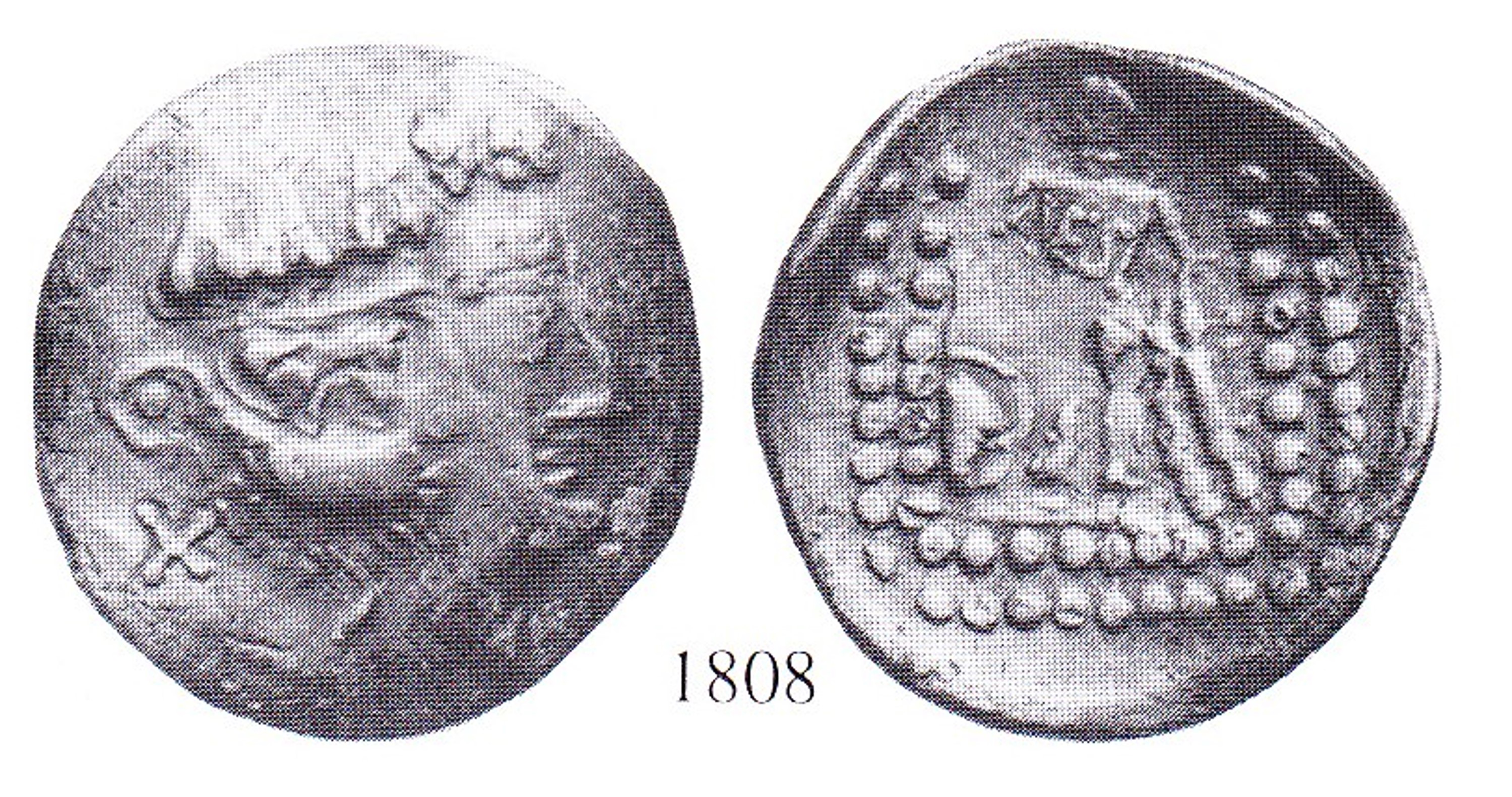1384 - Thasos (tetradrachm imitation Dionysus/Heracles) over Aesillas (Alexander/club) (Budapest, Dessewffy 548)
From SILVER
Location/history
| Museum collectionMuseum collection: | Budapest, Dessewffy 548 | |
Overstriking coin
Description
| ObverseInscription or printing placed on the obverse.: | ReverseInscription or printing placed on the reverse.: |
Mint and issuing power
| MintIdentifies the place of manufacture or issue of a numismatic object.: | Thasos | Ancient regionAncient region. | Thrace | Modern countryModern country: Greece | AuthorityIdentifies the issuing power. The authority can be "pretended" when the name or the portrait of X is on the coin but he/she was not the issuing power. It can also be "uncertain" when there is no mention of X on the coin but he/she was the issuing power according to the historical sources: |
Chronology
| FromIdentifies the initial date in a range assigned in a numismatic context. toIdentifies the final date in a range assigned in a numismatic context.. | periodTime period of the numismatic object. |
Physical description
| MetalThe physical material (usually metal) from which an object is made.: Silver |
WeightWeight of the numismatic object (in grams). in grams: 15.8815.88 g <br />15,880 mg <br /> | DenominationTerm indicating the value of a numismatic object. Examples: tetradrachm, chalkous, denarius.: Tetradrachm | AxisDescribes the directional relationship between the obverse and reverse of a numismatic object.: 1212 mm <br />1.2 cm <br /> |
| StandardStandard.: Attic | |||
References
| Coin referenceReference of the Coin: | Coin series referenceReference to coin series study: | Göbl 19741Göbl 1974, p. 49, n° 9, Lukanc 19962Lukanc 1996, p. 116, n° 1808, pl. 158 |
Overstruck type
Description
| ObverseInscription or printing placed on the obverse.: | MAKEΔONΩN (Greek) Head of the deified Alexander the Great right | ReverseInscription or printing placed on the reverse.: | AESILLAS (Latin) Q Money chest, club, and chair, all within laurel wreath |
Mint and issuing power
| MintIdentifies the place of manufacture or issue of a numismatic object. ᵖ: | Thessalonica | Ancient regionAncient region. ᵖ | Macedon | Modern countryModern country: Greece | AuthorityIdentifies the authority in whose name (explicitly or implicitly) a numismatic object was issued. ᵖ: | Aesillas (quaestor in the Roman province of Macedonia in c. 90 BC) |
Chronology
| FromIdentifies the initial date in a range assigned in a numismatic context. 95 toIdentifies the final date in a range assigned in a numismatic context.. 65 | Hellenistic 323-30 BC |
Physical description
| DenominationTerm indicating the value of a numismatic object. Examples: tetradrachm, chalkous, denarius. ᵖ: | Tetradrachm | StandardStandard. ᵖ: | Attic |
References
| Coin type referenceReference to coin series study ᵖ: | Callataÿ 1996b3Callataÿ 1996b, Bauslaugh 20004Bauslaugh 2000 |
Additional data
| Frequency of overstrikesFrequency of overstrikes: | rare and spread | Level of confidenceLevel of confidence of the identification: | sure |
| RemarksRemarks: | |||
References
- ^ Göbl, Robert (1974), Die Münzprägung der Ostkelten und ihrer Nachbarn, Braunschweig, Klinkhardt & Biermann, 136 p.
- ^ Lukanc, Ivo (1996), Les imitations des monnaies d'Alexandre le Grand et de Thasos, Wetteren, Cultura
- ^ Callataÿ, François de (1996), "Les monnaies au nom d'Aesillas", in T. Hackens (ed.), Italiam Fato Profugi Hesperinaque Venerunt Litora. Numismatic Studies Dedicated to Vladimir and Elvira Eliza Clain-Stefanelli, Numismatica Lovaniensia 12, Louvain-la-Neuve, p. 113-151.
- ^ Bauslaugh, Robert A. (2000), Silver coinage with the types of Aesillas the Quaestor, Numismatic Studies 22, New York.
